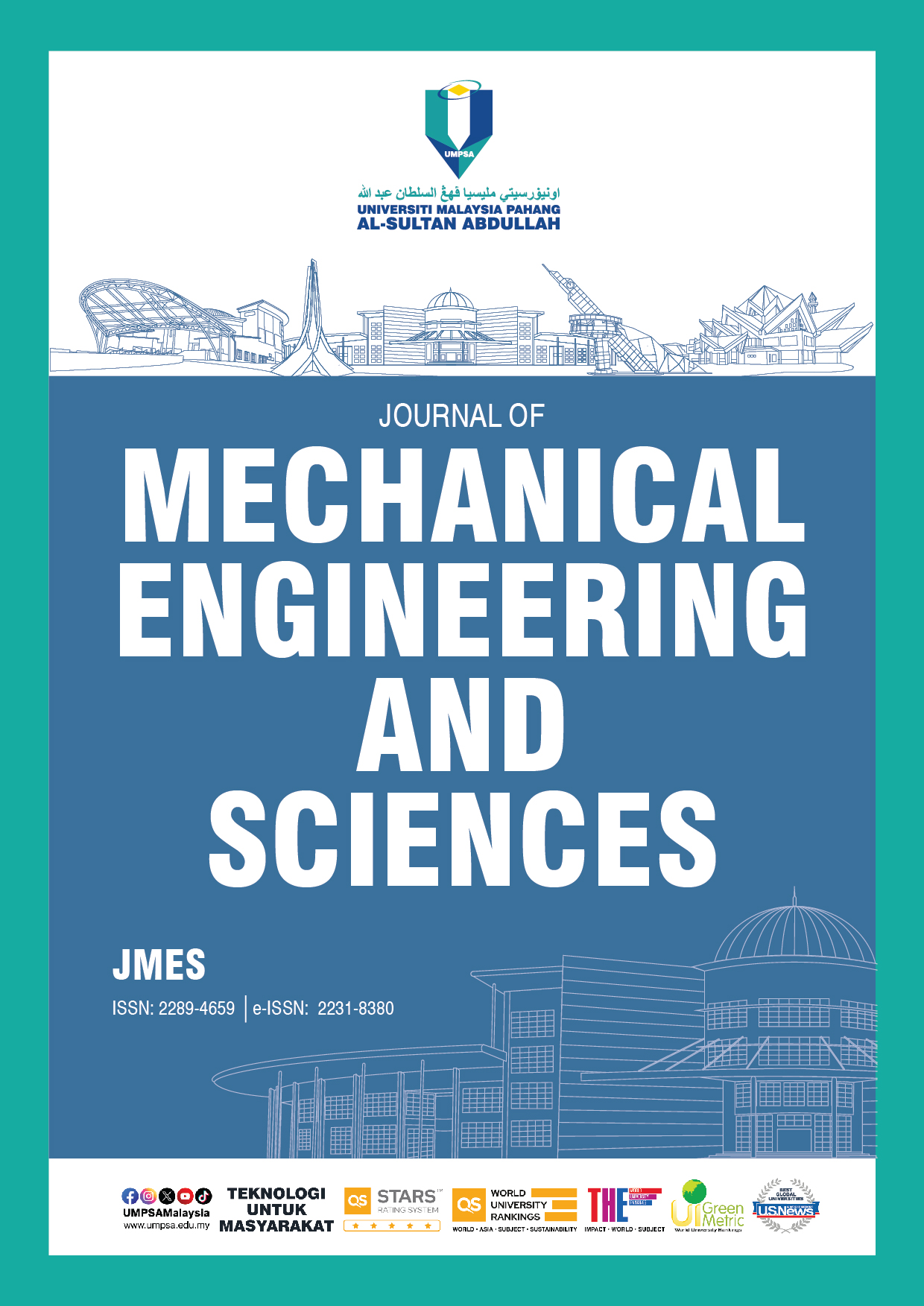Effect of the Mn and Cr contents on the oxidation and creep resistance at 1100°C of cast cantor–based HEAs
DOI:
https://doi.org/10.15282/jmes.18.2.2024.6.0793Keywords:
HEA alloys, CoNiFeMnCr, Manganese, Chromium, TaC and HfC, Hot oxidation, High temperature creepAbstract
Cast High Entropy Alloys (HEAs) derived from the Cantor’s composition may represent alternative substitutional solutions to the superalloys which are constituted for more than half of the critical elements nickel and cobalt. Recently, MC–alloyed HEAs constituted by a Cantor’s type matrix associated to an efficient interdendritic network of MC carbides, have demonstrated promising creep resistance at elevated temperatures. Regrettably, they also show poor high temperature oxidation resistance. This bad oxidation behavior is possibly due to the deleterious effect of manganese and to a too low content in chromium. New alloys were elaborated and tested in oxidation at 1100°C with thermogravimetry follow–up and metallographic characterisation, and their creep behavior was controlled. With less Mn and more Cr than the original alloys, these new alloys demonstrated significant progress in oxidation resistance. These changes in chemical compositions did not modify their creep resistances which were globally maintained, for the carbide-free alloy as well as for the MC-containing ones. These Mn-decreased and Cr-increased MC-containing alloys can be considered as low-cost alternative to polycrystalline Ni or Co-based superalloys for working in moderate conditions of corrosive fluids and applied mechanical stresses.
References
P. Wilson, R. Field, M. Kaufman, ”The use of diffusion multiples to examine the compositional dependence of phase stability and hardness of the Co-Cr-Fe-Mn-Ni high entropy alloy system,” Intermetallics, vol. 75, pp. 15–24, 2016.
J. Dabrowa, W. Kucza, G. Cieslak, T. Kulik, M. Danielewski, J.-W. Yeh, “Interdiffusion in the FCC-structured Al-Co-Cr-Fe-Ni high entropy alloys: Experimental studies and numerical simulations,” Journal of Alloys and Compounds, vol. 674, pp. 465–462, 2016.
A. Shafiei, “The design of eutectic high entropy alloys in Al-Co-Cr-Fe-Ni system,” Metals and Materials International, vol. 27, pp. 127–138, 2021.
G. Bracq, M. Laurent-Brocq, L. Perrière, R. Pirès, J.-M. Joubert, I. Guillot, “The fcc solid solution stability in the Co-Cr-Fe-Mn-Ni multi-component system,” Acta Materialia, vol. 128, pp. 327–336, 2017.
C. Konkati, A. Chauhan, “Incipient plasticity of a non-equiatomic Co21.5Cr21.5Fe21.5Mn21.5Ni14 multi-principal element alloy”, Metallurgical and Materials Transactions A, vol. 54, no. 10, pp. 3973–3987, 2023.
S. H. Joo, H. Kato, M. J. Jang, J. Moon, C.W. Tsai, J.W. Yeh, et al., “Tensile deformation behavior and deformation twinning of an equimolar CoCrFeMnNi high-entropy alloy,” Materials Science & Engineering A, vol. 689,
pp. 122–133, 2017.
T. Teramoto, K. Yamada, R. Ito, and K. Tanaka, “Monocrystalline elastic constants and their temperature dependences for equi-atomic Cr-Mn-Fe-Co-Ni high-entropy alloy with the face-centered cubic structure,” Journal of Alloys and Compounds, vol. 777, pp. 1313–1318, 2019.
M. A. Gianelle, C. Clapp, A. Kundu, and H.M. Chan, “Solid state processing of the cantor derived alloy CoCrFeMnNi by oxide reduction,” Results in Materials, vol. 14, p. 100286, 2022.
C. T. Sims, W. C. Hagel. The Superalloys, 1st Ed. New York, USA: John Wiley and Sons, 1972.
M. S. Donachie, S. J. Donachie. Superalloys: A Technical Guide, 2nd Ed. USA: ASM International, 2002.
P. Berthod, “Behavior in oxidation at 1000 °C of carbon-containing equimolar CoNiFeMnCr alloys added with hafnium or tantalum with high contents,” Journal of Chemical Engineering Research Updates, vol. 9, pp. 60–71, 2022.
P. Berthod, “Strengthening against creep at elevated temperature of HEA alloys of the CoNiFeMnCr type using MC-carbides,” in Supplemental Proceedings of the TMS 2023 Annual Meeting & Exhibition, pp. 19–23, 2023.
P. Kofstad. High Temperature Corrosion, 2nd Ed. London, UK: Elsevier Applied Science, 1988.
D. J. Young. High Temperature Oxidation and Corrosion of Metals. 2nd Ed. Amsterdam, Netherlands: Elsevier Corrosion Series, 2016.
G. Laplanche, U. F. Volkert, G. Eggeler, E. P. George, “Oxidation behavior of the CrMnFeCoNi high-entropy alloy,” Oxidation of Metals, vol. 85, no. 5-6, pp. 629–645, 2016.
G. R. Holcomb, J. Tylczak, C. Carney, “Oxidation of CoCrFeMnNi high entropy alloys,” JOM, vol. 67, no. 10, pp. 2326–2339, 2015.
Y. J. Li, A. Kostka, A. Savan, A. Ludwig “A. Atomic-scale investigation of fast oxidation kinetics of nanocrystalline CrMnFe-CoNi thin films,” Journal of Alloys and Compounds, vol. 766, pp. 1080-1085, 2018.
J. Mahaffey, A. Vackel, S. Whetten, M. Melia, A. B. Kustas, “Structure evolution and corrosion performance of CoCrFeMnNi high entropy alloy coatings produced via plasma spray and cold spray,” Journal of Thermal Spray Technology, vol. 31, no. 4, pp. 1143–1154, 2022.
M. L. Bürkner, L. Mengis, E. M. H. White, M. C. Galetz, “Influence of copper and aluminum substitution on high-temperature oxidation of the FeCoCrNiMn "Cantor" alloy,” Materials and Corrosion, vol. 74, no. 1, pp. 79–90, 2023.
P. Berthod, “Behaviors in oxidation at 1100 °C of an equimolar CoNiFeMnCr high entropy alloy and of its versions moderately added with HfC or TaC carbides,” High Temperature Corrosion of Materials, vol. 100, no. 3-4, pp. 177–191, 2023.
P. Berthod, “Kinetics of high temperature oxidation and chromia volatilization for a binary Ni–Cr alloy,” Oxidation of Metals, vol. 64, no. 3-4, pp. 235–252, 2005.
Downloads
Published
Issue
Section
License
Copyright (c) 2024 The Author(s)

This work is licensed under a Creative Commons Attribution-NonCommercial 4.0 International License.






